Learn exactly what persuasive techniques you need to use to build habit-forming products.
Based on years of studying successful startups all capable of fundamentally changing the day-to-day lives of their users, Nir Eyal has codified his findings on how to build habit-forming products into his Hook Model. In his bestselling book: “Hooked: How to Build Habit-Forming Products”1, Eyal explained how to make tech products sticky using habits. Specifically, Eyal studied how top tech companies has managed to create user habits, i.e. behaviors done with little or no conscious thought, and created an actionable framework that will allow you to reproduce the same results for your own product.
Eyal found that 50% of all that we do as people during a day, is done with little or no conscious thought: purely out of habit. So why not use the practice of habit design to design better products that are sticky? Eyal proposes a pattern to design habits that he calls “a hook”.
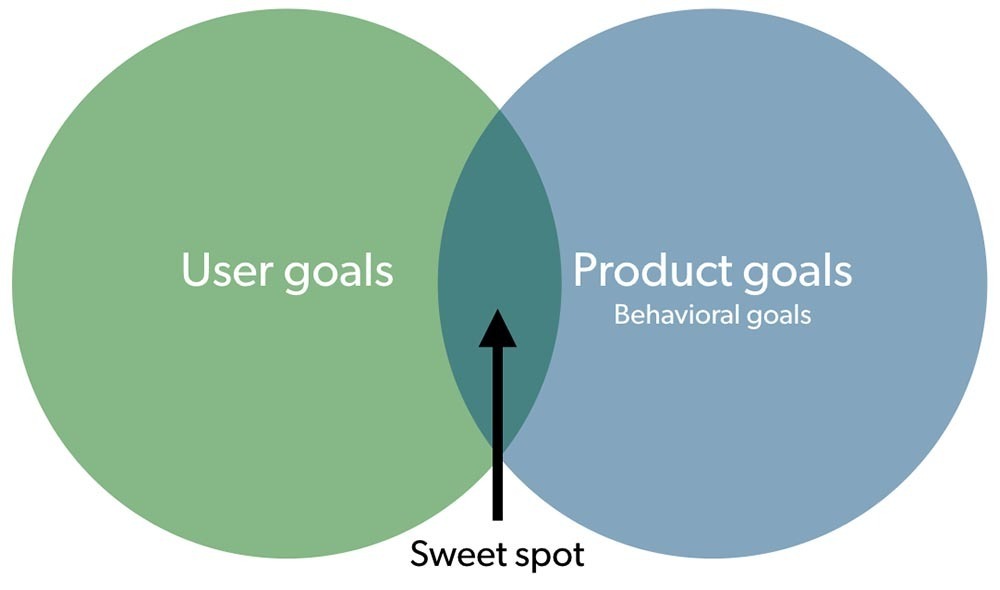
User goals and business goals need to match. Your goal is to connect the user's problem to your solution with enough frequency to form a habit.
A hook is very simply a design that connect your users’ problem to your solution with enough frequency to form a habit. Through successive passes through these hooks, habits can be formed. According to Eyal, this is how we start to shape, form, and create users’ tastes and preferences.
A hook is a cycle of events, engineered to keep users coming back and has four parts. They start out with a trigger, an action, a reward, and then an investment
The 4 stages of the hook cycle
The Hook cycle consists of 4 stages:
- Trigger
- Action
- Variable reward
- Investment
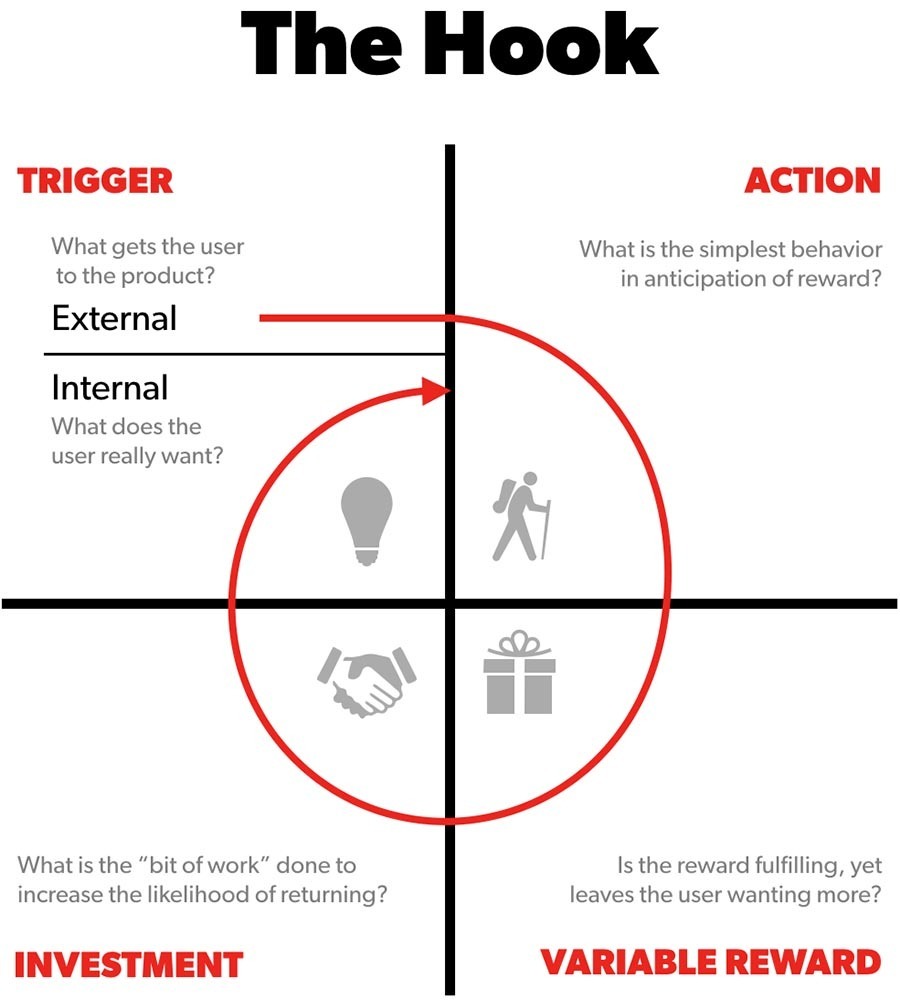
The Hook Model consists of a 4 staged cycle: A Trigger (internal or external), an action, a variable reward, and an investment to set the user up for another cycle through the loop.
Triggers
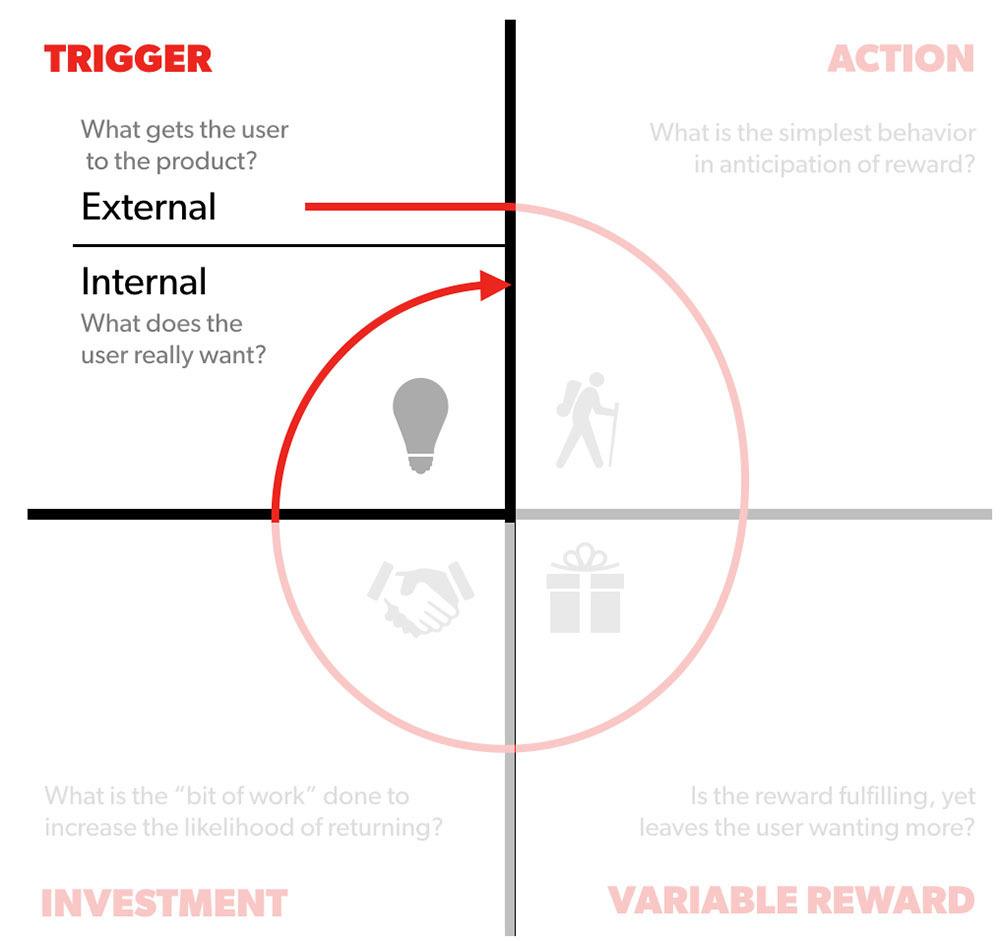
Triggers comes in two types: external triggers and internal triggers.
External triggers are those that explicitly cue our next action. If you are a designer, product developer, or entrepreneur, you will be very familiar with these. An external trigger could be a billboard, an email, a tweet, a play button, a cop standing on the corner telling you which way to go, an alarm clock, your friend suggesting through word of mouth what product you should try, or a buy button at a webshop. External triggers all contain the information of what to do next within them. The message of an external trigger is explicit and tangible.
Examples external triggers could be:
- Notifications. Inform your users about relevant and timely events when it makes sense for them to act on the information presented.
- Completeness Meter. Let users gauge their progress toward reaching a goal and highlight what actions they can take to move closer toward the finish line.
- Chat. Allow users to interact with each other and allow them to send external triggers to each other.
- Periodic Events. Construct recurring events to build up anticipation and sustained interest. Either tap into existing global events like the holidays or Black Friday sales, or create your own.
- Fresh Start Effect. We are more likely to engage in setting new goals and performing new behavior at the start of a new period in time.
Internal triggers also cue our next action, but unlike external triggers, the information of what to do next is not contained within the trigger, but rather through an association in the user’s memory. Internal triggers are in many cases neglected by designers, why mapping opportunities for internal triggers could be a key differentiator.
The associations internal triggers refer to could come in the form of the places we go to, the people we interact with, the routines we keep, concrete situations, and especially the emotions we feel. Negative emotions like feeling lonesome, indecisive, powerless, dissatisfied, bored, or inferior can all cue internal triggers. What we do in response to any of these dictates our habits just as reliably as the external triggers.
For people who feel down more frequently, those who are in a negative valence state, such as people who feel depressed, are more likely to associate negative emotions with internal triggers. Such internal triggers could cue users to check their email or social media accounts more frequently than the general population.
Several persuasive techniques can be used in combination with internal triggers to help eliminate negative emotions:
- Need for autonomy. If we feel powerless inferior, we strive to feel more in control. Increase the user’s perception of freedom to make his or her own decisions by speeding up interactions, splitting up tasks and attention, and reducing complexity.
- Framing. We tend to avoid risk when a positive frame is presented, but seek the same risks when the same information is presented in a negative frame.
- Nostalgia Effect. We feel more connected and are more likely to act, when we reminisce about past experiences.
Understanding what your users’ problems really are, can help you discover their internal triggers. That is, what internal trigger are you as a product builder trying to form an association with.
Action
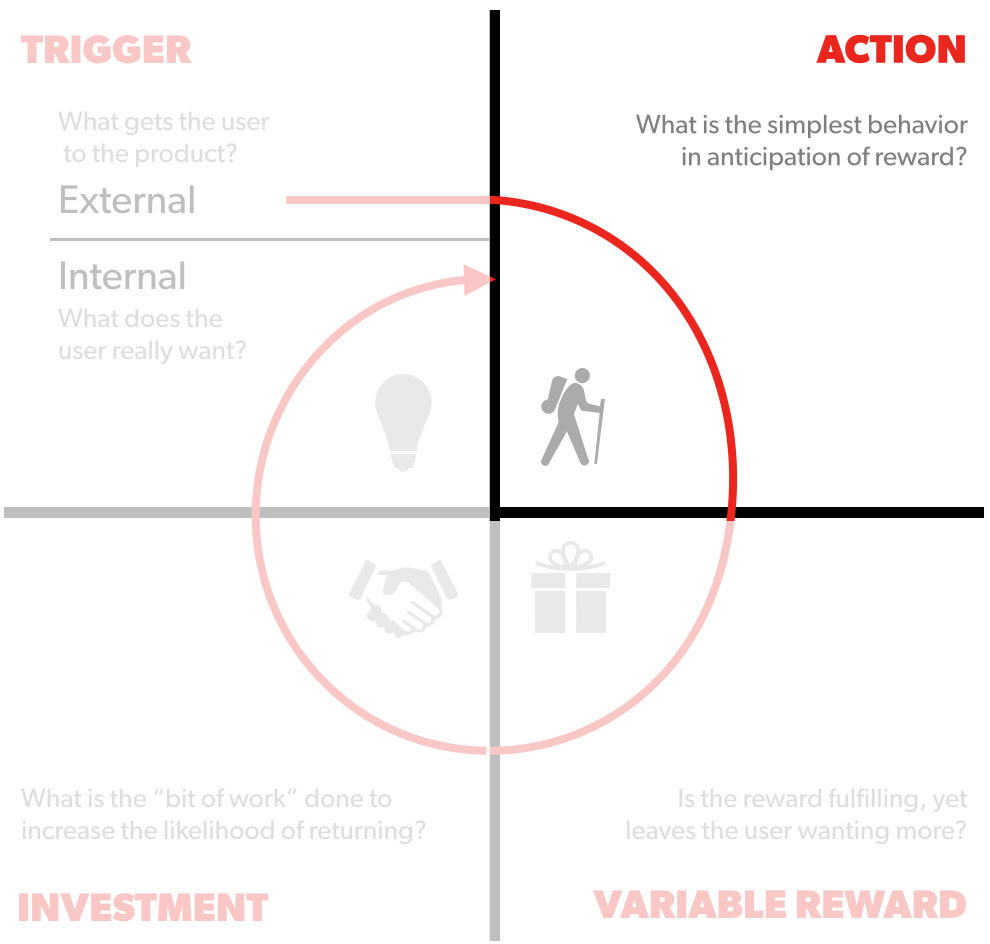
To get users to engage in a particular behavior, as a designer, you will want to focus on the simplest behavior you can get users to engage in with their anticipation of a reward. Behavior comes in many forms. Examples of simple behaviors could be a scroll on Instagram, a search on Google, or pushing the play button on YouTube.
To help us create designs that will drive people toward action, the research of BJ Fogg can help us. BJ Fogg, a notable persuasive tech researcher at Stanford, created the Fogg Behavior Model 4 to predict, with a simple formula, when a behavior will happen.

Fogg explains that for any human behavior to happen, three things need to converge at the same time:
- We need sufficient motivation
- We need sufficient ability
- We need to be triggered
Motivating toward a behavior
Motivation can be defined as the energy for an action5: how much we want to do something. Fogg suggests 3 core motivation drives to focus our motivation efforts toward:
- Anticipatory: We seek hope and avoid fear
- Sensational: We seek pleasure and avoid pain
- Social: We seek social acceptance and avoid social rejection
Making things easier to do to lower required ability
Where influencing motivation will up the energy users have to perform a specific behavior, making things easier to do will lower the energy required – the ability required to engage in a behavior. Our ability is our capacity to do a particular behavior: how easy of difficult something is. BJ Fogg suggests that there are 6 levers with which we can make something easier to do, and thus lower the needed ability:
- Time
- Money
- Physical effort
- Brain Cycles
- Social Deviance
- Non-routine
Learn what persuasive techniques you can use to influence each of the 6 levers in my article on Making the Fogg Behavior Model actionable.
The more we practice a particular behavior, the more likely it is to become a habit
In terms of habits, practising toward making a non-routine behavior routine, enforces the hook cycle. Routine behavior has a repeater effect that turns them into habits. The more we do a particular behavior, the easier that behavior becomes. As a result, as it becomes easier to do, we end up doing that behavior more frequently. In other words, the more we practice a particular behavior, the more likely it is to become a habit. As behavior becomes easier to do, we are more likely to engage in the same behavior in the future.
So when we are building a new product, it is useful to ask: “Why aren’t users using this specific action that we designed for them?”. To answer that question, we can ask:
- Does the user have sufficient motivation?
- Does the user have sufficient ability?
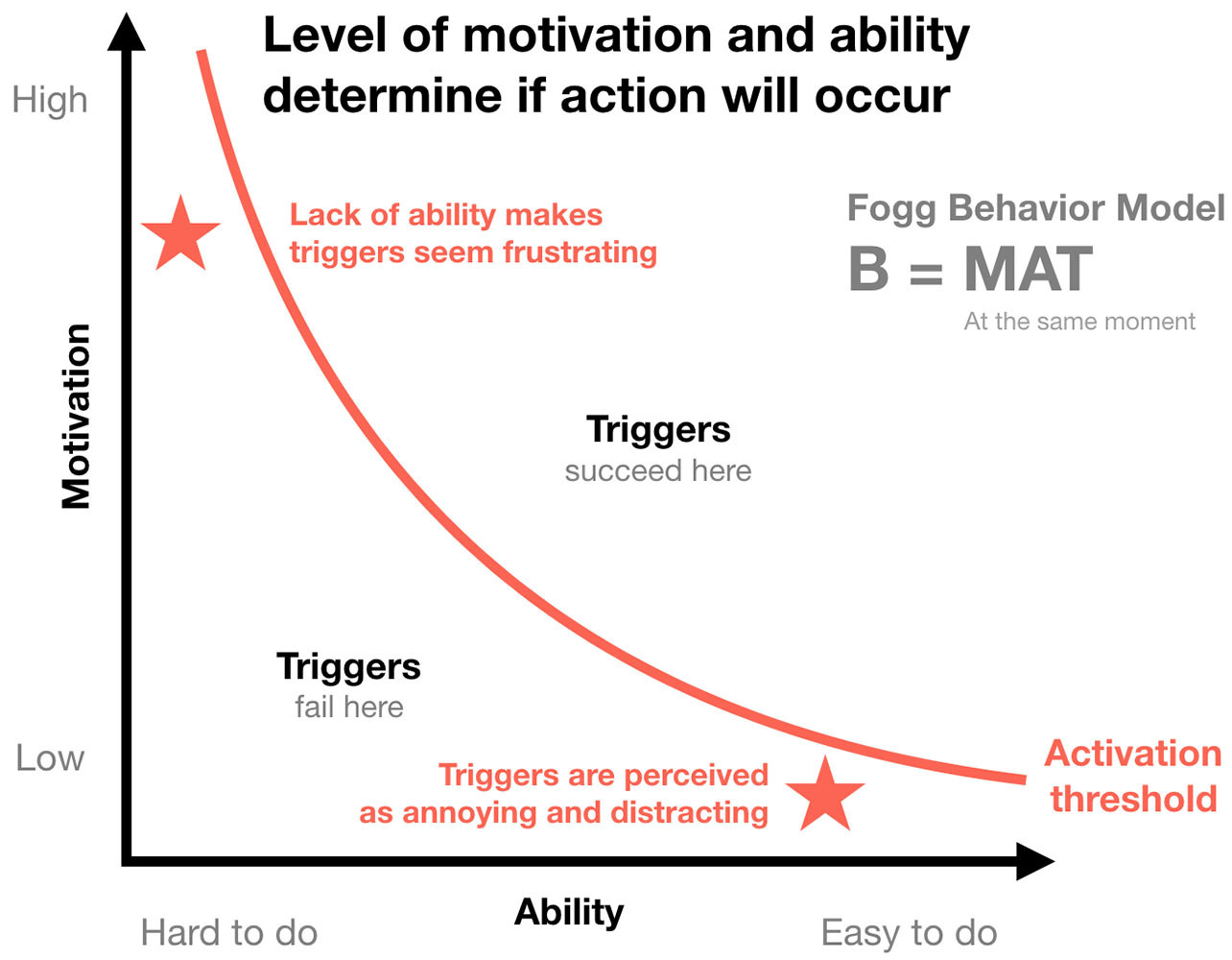
If something is easier to do, the behavior will be mapped to the right. If things are hard to do, the behavior will be mapped to the left. In the middle is an activation threshold. Triggers on the right side of the threshold succeed, triggers on the left side fail.
Designing powerful triggers
Finally, having a clearly defined trigger present must be there every single time to achieve the intended behavior. Be explicit about what you want the user to do.
I went through 50+ specific persuasive techniques that you can use to increase motivation, decrease the required ability to perform a particular behavior, and deploy powerful triggers in my article on Making the Fogg Behavior Model actionable.
Variable rewards
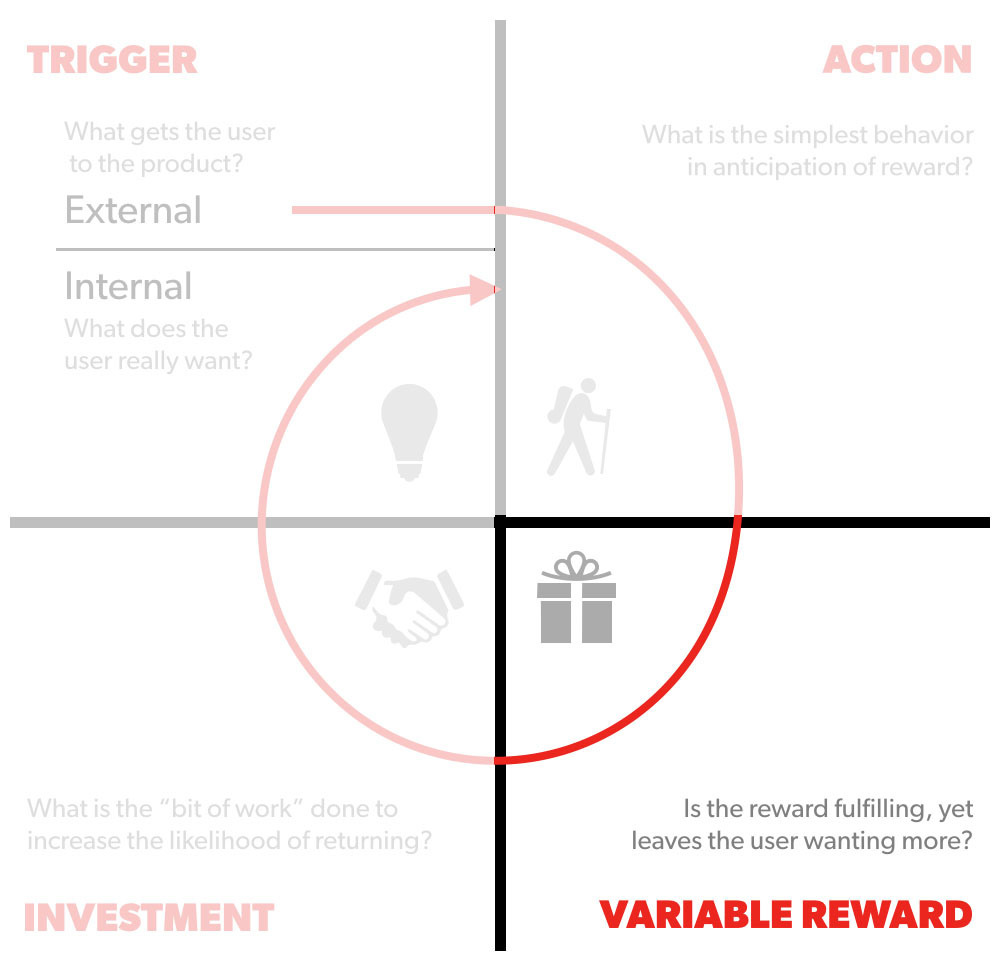
After we’ve figured out what triggers users and we’ve designed the simplest action in anticipation of a reward, it is time to give them what they came for: their reward.
In his book1 Eyal explains how it is not so much obtaining the reward in itself that makes us do a behavior, but rather the anticipation of a future reward. Research shows that certain parts of our brains (nucleus accumbens) light up in anticipation of a reward, more than receiving an actual reward. The same area that is lit up when we engage in sex, luxury goods, certain chemicals (drugs), and when we use technolgy. When we finally receive the anticipated reward, that same part of our brain immediately becomes less active.
The anticipation, or craving, turns out to be the reward system of our brains.
Building anticipation in the unknown
The unknown is fascinating. The mystery and intrigue of not knowing causes us to increase focus and engagement and in turn is a powerful cocktail for forming new habits.
The unknown-factor can be increased by adding variability in terms of when the reward is given and how big the reward is. As we are constantly unaware of exactly when we will receive a reward, we tend to keep engagement and focus at high levels (with stress to follow on the long term). The nucleus accumbens becomes stimulated with variability.
Types of variable rewards
The purpose of the rewards stage of the Hook model is to give people what they came for, but leave them wanting more. To leave them wanting more, keep an element of mystery and curiosity to leave them intrigued about what they might find the next time they engage.
Eyal describe three types of variable rewards: rewards of the tribe, of the hunt, and of the self.
Rewards of the tribe
Rewards of the tribe are social rewards. They are things that are variable in nature and feel good when we receive them from other people. Examples of these social rewards are empathetic joy, feeling good because someone else also feels good, partnerships, cooperation, and competition. In technology, social media specifically plays on rewards of the tribe, when we see our content gets commented, liked, or when we receive a message.
Persuasive techniques that play on rewards of the tribe include:
- Competition. We strive to obtain things that cannot be shared.
- Nostalgia Effect. When we reminisce about past experiences, we feel connected to those and release empathetic joy toward those connected.
- Status. We constantly assess how we stand socially and professionally and seek to enhance that position.
Rewards of the hunt
Rewards of the hunt are in many cases the hunt for material rewards – like winning in the lottery. However, it can also come in the hunt of information as we scroll through our SoMe feed or search for something on google: if I want more, I scroll.
Persuasive techniques that play on rewards of the hunt include:
- Completion. We are engaged in itself by completion of a goal.
- Unlocking features & Powers. We strive to obtain new levels of accomplishment and capabilities that will make us feel more in control and more powerful.
- Prolonged play. Reward users by letting them stay in the game for just a little longer.
Rewards of self achievement
Rewards of self achievement are intrinsically motivations like mastery, competency, consistency, accomplishment and control.
Persuasive techniques that play on rewards of the self include:
Investment
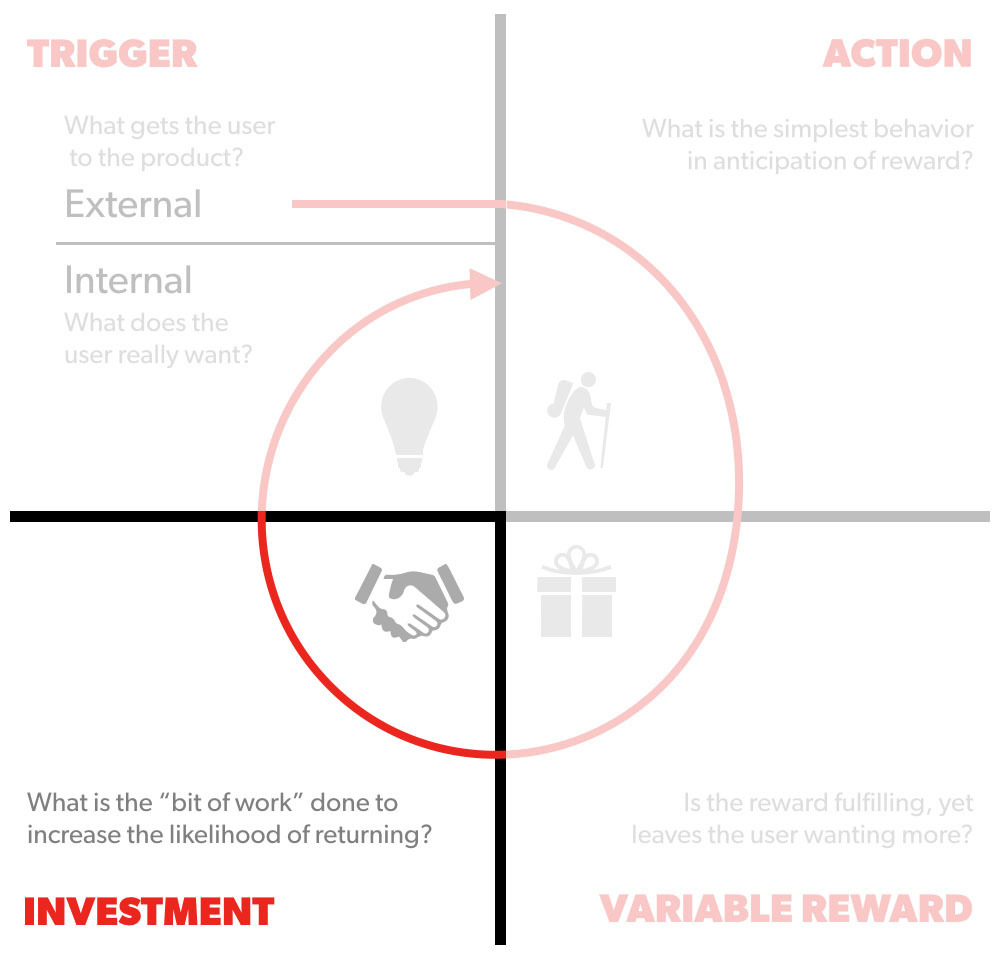
The final step of the hook model is the investment phase, which is about letting users set themselves up for future rewards. The investment phase is not so much about immediate gratification, which was covered by the “action” phase, but rather about a future reward that is to come. The goal of the investment phase is to increase the likelihood of the next pass through the hook. It does so in two ways:
- Investments load the next trigger of the hook. By sending a message to a friend, I set myself up for receiving a reply, which is a future reward (and an external trigger) that will bring me back into the hook cycle.
- Storing value. As habits are formed, the products that form them become more valuable over time with use. The more content I add, the more followers and comments I get, the higher reputation I have built up, the more valuable the aiding product becomes to me.
Does your product have the potential to become habit-forming?
To sum up the Hook Model and check whether your product has the potential of becoming a habit-forming product, you should ask these five questions:
- What internal trigger does your product address?
- What external trigger prompts the next action?
- With the anticipation of reward, what is the simplest behavior users can do?
- Is the reward fulfilling and leaves the user wanting more?
- What is the bit of work to increase the likelihood of the next pass through the hook cycle?
Sources
1 Nir Eyal with Ryan Hoover, 2014, Hooked: Building Habit Forming Products, 2014
2 Nir Eyal, 2014, Hooked: Building Habit Forming Products video of conference talk at the TNW conference
3 Silvia Li Sam, 2016, Nir Eyal: The psychology of Building Addictive Products
4 Anders Toxboe, 2019, Making the Fogg Behavior Model actionable at UI-Patterns.com
5 Deci, E., "Self-Determination Theory: A Macrotheory of Human Motivation, Development and Health”, available as PDF, 2008
6 Self-Determination Theory at Learning Loop

